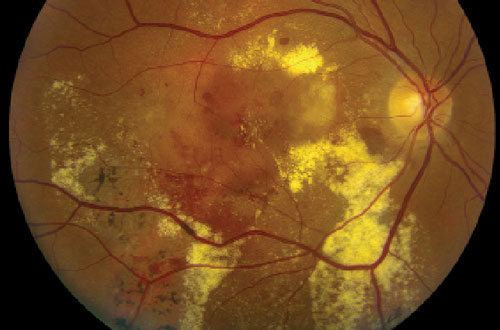 |
| PCV is more common in people of Asian descent, who tend to present with severe disease characteristics. Photo: Mark Dunbar, OD |
Current literature suggests polypoidal choroidal vasculopathy (PCV) is more prevalent in those of Asian descent compared with individuals from Western countries with predominantly Caucasian populations. A new investigation used multimodal imaging to pinpoint differences in PCV disease characteristics between Asians and Caucasians, indicating the physiological processes associated with the disease may vary based on ethnicity.
The study included 250 treatment-naïve patients (128 Asians and 122 Caucasians) diagnosed with PCV based on indocyanine green angiography images. Participants were seen at either the Eye Clinic of the Luigi Sacco Hospital in Italy, the Moorfields Eye Hospital in the United Kingdom or the Singapore National Eye Center. The researchers considered patient demographics and evaluated different imaging methods, including color fundus photography, spectral domain optical coherence tomography, fluorescein angiography and indocyanine green angiography.
In Asians, the investigators found that disease was more severe, with lower BCVA (0.7±0.6logMAR vs. 0.4±0.3logMAR) and concomitantly more occurrences of subretinal hemorrhage (54% vs. 25%) and larger areas of hemorrhage (7.5±15.2mm2 vs. 1.3±3.3mm2) compared with Caucasians.
Also of note: Asian eyes had more pachy vessels (84% vs. 29%), choroidal vascular hyperpermeability (70% vs. 17%) and widespread polypoidal lesions (10% vs. 8%). On the other hand, Caucasians had more drusen (80% vs. 49%). This may suggest a mechanism more closely related to typical wet AMD in the Caucasian population, the authors suggested.
Overall, these phenotypic differences may impact the potential treatment choicesfor PCV, the researchers explained. Since larger polypoidal lesions have been found to be more resistant and persist despite anti-VEGF monotherapy, these cases may be more responsive to combination therapy with anti-VEGF and adjunctive photodynamic therapy with verteporfin, they added.
“It should be noted that race or ethnicity are not considered biologically meaningful for genetic risk factors,” the researchers wrote in their paper. “Genetic studies now suggest similarities between individuals rather than populations.” For this reason, clustering of individuals can correlate with geographic origin or ancestry, and also with some traditional concepts of race. “Therefore, ancestry and even ethnicity may in some cases prove useful in the biomedical setting, but direct assessment of disease-related genetic variation will ultimately yield more accurate and beneficial information.”
Corvi F, Chandra S, Ivernizzi A, et al. Multimodal imaging comparison of polypoidal choroidal vasculopathy between Asian and Caucasian population. Am J Ophthalmol. August 23, 2021. [Epub ahead of print]. |

